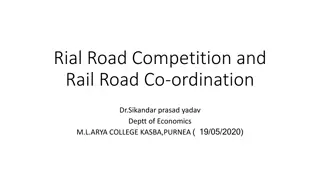Introduction to Co-ordination Chemistry: Fundamentals and Applications
Explore the fascinating field of coordination chemistry, delving into the complexity of compounds and the coordination bonds that govern their structures. Discover the history, key concepts, and applications of coordination chemistry through a detailed examination of coordination compounds, bonding theories, isomerism, and more. Unveil the significance of this branch of inorganic chemistry in industrial processes and life sciences, tracing its evolution from the pioneering works of Alfred Werner and others.
Download Presentation

Please find below an Image/Link to download the presentation.
The content on the website is provided AS IS for your information and personal use only. It may not be sold, licensed, or shared on other websites without obtaining consent from the author.If you encounter any issues during the download, it is possible that the publisher has removed the file from their server.
You are allowed to download the files provided on this website for personal or commercial use, subject to the condition that they are used lawfully. All files are the property of their respective owners.
The content on the website is provided AS IS for your information and personal use only. It may not be sold, licensed, or shared on other websites without obtaining consent from the author.
E N D
Presentation Transcript
WEL-COME Dr. D . N. Zambare Department of Chemistry , Kisan Veer Mahavidyalaya, Wai (Satara)
Chapter 1Co-ordination Chemistry Contents 1.1 Introduction-Definition and Formation of Co-ordinate Covalent Bond in BF3 - NH3, [NH4]+, and H2O 1.2 Distinguish between Double Salt and Complex Salt 1.3 Werner s Theory 1.3.1 Postulates 1.3.2 The Theory as Applied to Cobalt Ammines viz. CoCl3.6H2O, CoCl3.5H2O, CoCl3.4H2O, CoCl3.3H2O 1.4 Description of the Terms - Ligands, Co-ordination number,Co- ordination sphere, Effective Atomic Number (EAN) 1.5 IUPAC Nomenclature of Co-ordination Compounds 1.6 Isomerism in complexes with C.N. 4 and 6 1.6.1 Geometrical Isomerism 1.6.2 Optical Isomerism 1.6.3 Structural Isomerism-Ionisation Isomerism, Hydrate Isomerism, Coordination Isomerism, Linkage Isomerism and Co-ordination position Isomerism 1.7 Valence Bond Theory of transition metal complex with respect to C.N. = 4 complexes of Cu, Ni, and C. N. = 6 complexes of Fe, Co
Introduction The most amazing field of modern inorganic chemistry is co-ordination chemistry! It pertains to the study of complexity of compounds. A large body of current inorganic research is going on this extremely attractive field of science which is in the state of rapid progress. It plays an important role in the chemical industry and in life processes. The recent study of co-ordination chemistry stems from the work of Alfred Werner and Sophus Mads Jorgensen. Alfred Werner was the first inorganic chemist who was awarded the Nobel Prize in chemistry was awarded jointly to Dr. K. Ziegler and Prof. G. Natta for the Ziegler-Natta catalyst, a complex of aluminium and titanium. The Nobel Prize for chemistry was awarded to Prof. Wilkinson in 1973 for his work on -complexes. This confirms the importance of co-ordination chemistry. In this chapter, students will become familiar to the co-ordination bond and insight of co-ordination chemistry
1.1 Definition and Formation of Co-ordinate Covalent Bond in BF3 - NH3 , [NH4]* and H2O:- Co-ordinate covalent bond 1. Definition Chemical bond: The force of attraction between the atoms within a molecule is known as chemical bond. Covalent bond: The force developed by an equal sharing of a pair of electrons between the two atoms is known as an electron pair bond or covalent bond. Co-ordinate bond: According to Lewis, a special kind of electron pair bond formed when both electrons are contributed by one atom only is known as a co-ordinate covalent band or simply a co-ordinate bond. According to the orbital concept, a co-ordinate bond is formed when an orbital containing a lone pair of electrons in one atom overlaps with an empty orbital from the other atom. Specifications: (i) The co-ordinate bond once formed is indistinguishable from the normal covalent bond. (ii) The atoms which donate the pair of electron are called the donor atom and the other atom which simply accepts the
Formation of Co-ordinate (Covalent) Bond: The mechanism of formation of a co-ordinate bond may be visualized as a two step process which is an amalgamation of electrovalent and covalent bindings. Suppose A is a donor and B the acceptor. Step I: At the initial stage, one electron from the lone pair on A is transferred to B whereby gains a unit positive charge while B receives a unit negative charge. In other words, this is a process of transfer of electrons as observed in ionic bonding. (with a lone pair of electron) Step II: In the second stage, these two electrons one each from A+ and B join together and form a pair of electrons which is shared between A and B just similar to covalent bonding. A+. and . B+ A : B or A B Co-ordination bond is thus the joint effect of ionic and covalent bondings. The co-ordinate bond is therefore termed as co-ionic bond, semi-polar bond or dative covalent bond.
Conditions for formation of co-ordinate bond: 1. The atom acting as a donor should have a lone pair of electrons. 2. The atom acting as an acceptor should have a vacant orbital to accept the lone pair of electrons donated by the donor. 3. Donor with its lone pair of electrons should overlap appreciably with vacant orbital of acceptor and should donate and share its electron pair with acceptor. Examples of Co-ordinate Covalent Bond: 1. Formation of BF3:NH3 Molecule: Boron trifluoride reacts with ammonia where a co-ordinate bond is formed between nitrogen and boron. Here nitrogen from ammonia acts as a donor atom while boron from boron trifluoride acts as an acceptor atom. Nitrogen donates and shares an electron pair with boron and forms a co-ordinate bond.
2. Formation of Ammonium Ion, NH4+: In ammonia molecule, the central atom is nitrogen. It has four sp3 orbitals, one of these contains a lone pair of electrons while the three contain bond pairs as shown in Fig. 1.1. The empty s-orbital from an H+ ion overlaps with the orbital of nitrogen atom containing lone pair of electrons and forms ammonium ions as shown in Fig. 1.1.(a) Fig. 1.1(a) Formation of co-ordinate bond in ammonium ion
3. Formation of Water molecule [H2O]: In water molecule, the central atom is oxygen. The electronic configuration of oxygen is, 1s2, 2s2, 2p4. It has four sp3 orbitals, two of these contains a lone pair of electrons while the two contain bond pairs as shown in Fig. 1.1.(b) Here, two loan pairs occupy more volume in space, since they are under the influence of only one nucleus. Hence, loan pair loan pair repulsion is greater than loan pair bond pair repulsion which is greater than bond pair bond pair repulsion. Consequently, expected bond angle 109.50 is reduced to 104.50. Water molecule has distorted tetrahedral structure as shown in fig.1.1(b) Fig. 1.1(b) Structure of water molecule
1.2 Distinguish between Double Salt and Complex Salt Double salts Definition 1. The molecular compounds which exist only in the form of crystal lattices but which break down into their component parts when dissolved in water (or in any other ionic solvent) are known as double salts. Alternatively, double salt may be defined as an addition compound, altogether different in crystal lattice, which crystallizes out as a homogeneous material from the solution of pair of simple salts. Complex salts Definition 1. The addition or molecular compounds which retain their molecular identities (i.e. do not lose their properties) even when dissolved in water (or in any other ionic solvent) and which differ completely in their properties from those of their parent constituents are called as complex salts or co- ordination compounds or complex compounds. Alternatively, co-ordination compound is defined as a molecular compound containing a central atom or ion, usually a metal, surrounded by a group of atoms, ions or molecules. It is also known as a metal complex or simply a complex. 2. Double salts differ in crystal form but retain their ionic characteristics as those of the parent compounds. They possess no striking features as such. 3. Double salts are the neutral molecular species that exist in the solid crystalline state only. 2. These compounds are characterized by a set of striking properties and differ completely from the parent salts. 3. Co-ordination compounds may be cationic, anionic or neutral molecular species found both in solid form and solution form. 4. Double salts are the compounds whose physical and chemical properties are mostly the same as those of the parent salts. 4. Complex salts are the compounds whose physical and chemical properties are quite different from those of parent salts. 5. They do not dissociated into their constituent ions and have independent existence, when dissolved in water or other solvents. 5. They get dissociated into their individual components when dissolved in suitable solvent. 6. The solutions of double salts have essentially the same properties as a mixture of the individual compounds, and give tests for all the ions from the parent salts. 6. These compounds do not give tests for all the component ions from the parent substances. They may give tests for a complex cation or a complex anion and a simple ion.
6. The solutions of double salts have essentially the same properties as a mixture of the individual compounds, and give tests for all the ions from the parent salts. 6. These compounds do not give tests for all the component ions from the parent substances. They may give tests for a complex cation or a complex anion and a simple ion. 7. Double salts are the addition compounds which retain their identity only in the solid state but lose their identity in solution. 8. Some examples of double salts are: 1. Carnallite: KCl.MgCl2, 6H2O 2. Mohr s salt: FeSO4.(NH4)2SO4, 6H2O 3. Potash alum: K2SO4.Al2(SO4)3, 24H2O 7. Complex salts or complex compounds are the addition compounds which do not lose their identity even in solution. 8. Some examples of complex compounds are: 1. Potassium ferrocyanide: 4KCN.Fe(CN)2 i.e. K4[Fe(CN)6] 2. Potassium argentocyanide: KCN.AgCN i.e. K[Ag(CN)2] 3. Tetramminecopper sulphate Monohydrate: CuSO4.4NH3, H2O i.e. [Cu(NH3)4]SO4, H2O 4. Sodium cobaltinitrite: 3NaNO2.Co(NO2)3 i.e. Na3[Co(NO2)6] 5. Hexamminecobaltic chloride: CoCl2.6NH3 i.e. [Co(NH3)6]Cl3 9. If we add aqueous solution of ammonia to pink coloured solution of cobalt chloride, CoCl3, the pink colour changes to orange yellow. The Co3+ ions almost disappear from the solution. Ammonia enters into intimate association with Co3+ ion and yields a new ion [Co(NH3)6]3+, called a complex ion. The solution on evaporation, yields orange coloured crystalline solid corresponding to the formula [Co(NH3)6]Cl3 and possesses unique properties. This compound is 9. An aqueous solution of Carnallite shows physical and chemical properties of K+, Mg2+, and Cl ions, which are shown by the mixture of the solutions of KCl and MgCl2. Similar behavior is shown by other double salts.
3 Werners Theory(Werners concept of Auxiliary Valence): 1.3.1Postulates(Basic Postulates of Werner s Theory) The basic postulates of Werner s theory may be given as: 1. Most of the metallic elements exhibit two types of valencies. (i) Principal or primary valence and (ii) Secondary valence. 2. Every metal tends to satisfy both of its primary and secondary valencies. 3. Every metal has a fixed number of secondary valencies. 4. The secondary valence its always directed towards fixed position in space. Salient Features or Postulates: 1. The principal valence also known as primary valence or ionisable valence is designated by solid line ( ). In modern terms, it corresponds to the oxidation state of the metal ion. The secondary valence also called as auxiliary valence, subsidiary valence, residual valence or non-ionisable valence, is designated by dashed line (---). In recent terms, it corresponds to the co-ordination number of the metal ion, i.e. CN.
2. (i) The primary valencies are those which a metal ion exercises towards the negative groups so that its normal charge is satisfied by the formation of simple salts. For example: Primary valencies of Pt, Co, Cu, Ag are 4, 3, 2, 1 respectively whereby they produce simple salts viz. PtCl4, CoCl3, CuCl2 and AgCl respectively. (i)The secondary valencies are those which may be satisfied by negative ions, neutral molecules or both so that complex species is formed. For example: Co3+ has secondary valence six. Hence Co3+ forms complexes such as [Co(NH3)6]3+, [Co(NH3)5Cl]2+, [Co(NH3)4Cl2]+, [Co(NH3)3Cl3], etc. Sometimes negative groups show a dual behavior. They may satisfy primary as well as secondary valencies . It is invariably found that when a negative group satisfies one secondary valence, it necessarily satisfies one primary valence also. 3. Every element is characterized by its fixed secondary valence. For example: Fe(II), Co(III) and Pt(IV) have CN = 6, Cu(II) has CN = 4, Ag(I) has CN = 2, etc. 4. The primary valances are non-rigid and non-directional. On the other hand, secondary valencies have directional properties. The geometry of the complex is determined by the number and position of the secondary valence in space. This postulate, therefore, decides the stereoisomerism in complexes. If a metal ion has a secondary valence four, the geometry of the complex can be either square planar or tetrahedral. On the other hand, if the metal ion has secondary valence six, the geometry of the complex would be octahedral.
1.3.2Werners Theory in the Light of Modern Electronic Theory of Valence : According to Werner, the combining capacity of a metal is considered in the form of two spheres of attraction or two zones of attraction. 1.The first or the inner zone surrounding the metal is called as co- ordination sphere. Neutral molecules or negatively charged ligands are linked by co-ordinate bonds to the central metal ion in this zone. As the linking is rigid and tight, this sphere functions as a nonionizable zone. The secondary valence plays its role in this zone. In terms of electronic theory of valence, the secondary valence is identified as co- ordination number of the metal ion. 2. The second or the outer zone, surrounding the co-ordination zone is called as ionization sphere. In this zone, the metal ion satisfies its primary valence by linking with negatively charged ions which get ionized on dissolving the complex in water. Hence the primary valence is identified as the ionizable valence or electrovalency according to modern theory. To distinguish between the two spheres of attraction, Werner introduced the square brackets [ ], to enclose the co-ordination sphere of the complex compound. Schematically, the two spheres of attraction for the metal ion forming the complex may be as shown in Fig. 1.2.
Fig. 1.2: Two spheres of attraction of a metal 1.3.3 Application of Werner s Theory to Cobalt Ammine 1.3.3 Application of Werner s Theory to Cobalt Ammine (The theory as applied to cobalt ammines viz. CoCl3.6H2O, CoCl3.5H2O, CoCl3.4H2O, CoCl3. 3H2O).
(A) CoCl3.6NH3 or [Co(NH3)6]Cl3 (B) CoCl3.5NH3 or [Co(NH3)5Cl]Cl2 (c) CoCl.4NH3 or [Co(NH3)4Cl2]Cl (D) CoCl3.3NH3 or [Co(NH3)4Cl3]
Experimental Observations of Werners Theory: In all these co-ordination compounds, according to Werner: 1. The primary valence (or oxidation state) of cobalt is 3 while secondary valence (or co-ordination number) is 6. 2. When cobalt ammines are treated with hydrochloric acid and heated at 100 C (373 K), ammonia is not removed.Because it is bounded by co-ordinate bond. 3. All these compounds are found to differ in their electrical conductivity. 4. All these complexes differ in their reactivity towards silver nitrate. With these guidelines, let us study the individual ammines one by one.
(i) CoCl3.6NH3 or [Co(NH3)6]Cl3: Thus CoCl3.6NH3 may be pictured as shown in Fig. 3.3 (A). Here solid one represents primary valence of cobalt while hollow or broken line represents secondary valence. 1. On treatment with AgNO3: CoCl3.6NH3 immediately gives precipitate on silver chloride corresponding to all the three chloride ions. Hence all the three chlorides must be in the ionization sphere and satisfy the primary valence of Co. CoCl3.6NH3 + Excess Ag+ 3AgCl 2.On treatment with HCl: As ammonia is not removed, it must be strongly bound to cobalt. Hence all the six ammonias must be in the co-ordination sphere of the complex and they must be satisfying secondary valence of cobalt. 3.Cryoscopic measurementand molar conductivity data: CoCl3.6NH3 indicates the presence of four particles. Corresponds to six charges for the solution of CoCl3.6NH3 in nitrobenzene. From these observations, formulation of CoCl3. 6NH3 must be done as [Co(NH3)6]Cl3. The ionization would be then [Co(NH3)6]Cl3 [Co(NH3)6]3++ 3Cl
(ii) CoCl3.5NH3 or [Co(NH3)5Cl]Cl2: From the above discussion one may predict that CoCl3.5NH3 should be formulated as [Co(NH3)5Cl]Cl2 and represented structurally as in Fig. 1.3 (B), in accordance with Werner s theory. The observed properties which support the above formulation are 1. On treatment with AgNO3: It gives precipitate of AgCl corresponding to two chlorides which must be in the ionization sphere. CoCl3.5NH3 + Excess Ag+ 2 AgCl 2. On treatment with HCl: All the ammonias are strongly bound and are not removed on treatment with HCl. They must be linked to cobalt with strong bonds and must be in co-ordination spheres. 3. Cryoscopic measurements and molar conductivity data: There must be three ions i.e. three particles and four charges for CoCl3.5NH3. It is evident from its ionization. [Co(NH3)5Cl]Cl2 [Co(NH3)5Cl]2++ 2Cl
(iii) CoCl3.4NH3 or [Co(NH3)4Cl2]Cl: This compound should be formulated as [Co(NH3)4Cl2]Cl and to be represented as shown in Fig. 1.3 (C), in accordance with Werner s theory. The observed properties which support the above formulation are 1. On treatment with AgNO3: It gives precipitate of AgCl corresponding to one chloride which must be in the ionization sphere. MCoCl3.4NH3 + excess Ag+ AgCl 2.On treatment with HCl: All the ammonias are strongly bound and are not removed on treatment with HCl. They must be linked to cobalt with strong bonds and must be in co-ordination spheres. 3. Cryoscopic measurements and molar conductivity data: Hence all four NH3 molecules are strongly bound to cobalt and must be in the co- ordination sphere. Its ionization leads to two ions and two particles as shown below: [Co(NH3)4Cl2]Cl [Co(NH3)4Cl2]+ + Cl
(iv) CoCl3.3NH3 or [Co(NH3)4Cl3]: This compound should be formulated as [Co(NH3)3Cl3] where all the three chloride ions are present in the co-ordination sphere. There is no evolution of NH3 on treatment with HCl or no precipitate of AgCl with AgNO3. The complex does not ionize. It is uncharged, neutral molecular species and exists as a single particle. This can be represented structurally as shown in Fig. 1.3 (D). The observed features of cobalt ammines may be summarized in Table 1.2. Table 1.2: Properties of Cobalt (III) ammines Composition (Empirical formula) Number of Cl ions precipitated by AgNO3 Number of Ions / particles Total charge Molar Structure (Werner s Formulation) Conductivity mmho cm-2 mmol-1 [Co(NH3)6]3+, 3Cl CoCl3.6NH3 3 4 6 432 [Co(NH3)5Cl]2+, 2Cl CoCl3.5NH3 2 3 4 261 [Co(NH3)4Cl2]+,Cl CoCl3.4NH3 1 2 2 124 CoCl3.3NH3 0 1 0 - [Co(NH3)3Cl3]
1.4 Description of the Terms - Ligands, Co-ordination Compounds: i) Ligand : Definition:In a complex compound, central metal ion is surrounded by or directly attached to other atoms, ions or molecules. These surrounding groups are called as the ligands. (The word stems from Greek, ligare meaning to bind). For example, NH3 in [Co(NH3)6]3+, is the ligand which is co-ordinated to Co3+ to form the complex. Hence ligand is also called as a co-ordinating group or a complexing agent.The Werner s formulation is self-explanatory to account for ligand Types: The ligands may be atomic, ionic or molecular species. For example: 1. Neutral molecular ligands 2. Negatively charged ligands. 3. Positively charged ligands. Table 1.3: Different types of ligands with examples Negatively charged ligands Br Names Positively charged ligands N2H Names Neutral Molecular ligands NH3 Names Bromo Hydrozinium amine NO+ F Fluoro Nitrosonium H2O aqua O2 Oxo NO Nitronium NO nitrosyl
OH Hydroxo CO carbonyl CN Cyano O2 Dioxygen C2O Oxalato N2 Dinitrogen CO Carbonato C5H5N Pyridine CH3COO Acetato H2NCH2CH2NH2 Ethylenediamine SO Sulphato H2NCSNH2 Thiourea NH Amido P(C6H5)3 Triphenylphosphine NO Nitrato C5H5 Cyclopentadienyl
Some typical illustrations have been given in Table 3.5. All these are called chelate ligands or chelating agents. Table 1.5 1. Bidentate (two toothed) 2. Tridentate (three toothed) 3. Quadridentate 4. Sexadentate Ethylenediamine tetra-acetic acid (EDTA) Ligand Examples Glycine, Ethylenediamine, Oxalate ion, Dimethyl glyoxime, Ortho- phenanthroline, etc. Diaminopropionic acid, Triaminopropane, Diethylene triamine, etc. Triethylene tetrammine Ethylenediamine: H2N* CH2 CH2 N*H2 Diethylenetriamine: H2N* (CH2)2 N*H (CH2)2 N*H2 Triethylenetetramine: H2N* (CH2)2 N*H (CH2)2 N*H (CH2)2 N*H2 where starred (*) atoms are the donor atoms. 5. Many of the properties of the co-ordination compounds are governed by the charge on the ligand and the number and nature of the donor groups on the ligand. Based on the co-ordinating ability, the common ligands may be arranged as follows: CO, CN > NO> en > NH3 > NCS > H2O > F > RCOO > OH > Cl > Br > I Tsuchida Fajans Spectrochemical Series. >------------ Co-ordinating ability decreases 6. The ligands are arranged round the central metal ion inside the first or the inner sphere of attraction, essentially in a regular geometrical pattern such as linear, triangular, planar, tetrahedral, square planar, trigonal bipyramidal, square based pyramidal and octahedral. The ligands play the most important role in deciding the features of the co-ordination compounds.
ii) Co-ordination Number (CN): The maximum number of groups directly attached to the central metal atom/ion, in an co- ordination compound, is known as the co-ordination number of the metal atom/ion. It is often abbreviated by the symbol (CN). It is the characteristic property of the metal. It takes the values from 2 to 8 where 4 and 6 co-ordination numbers are very common. It has been noted that light transition metal prefers to exhibit CN = 4 and 6 while the heavier transition metal prefers higher CN, say 8. Usually a given metal ion has a fixed CN but some metal ions may exhibit more than one co-ordination number. The study of CN has revealed that normally the co-ordination number of metal ion is twice the oxidation state of the metal. All such features of CN can be understood by studying the Table 3.6.Table 1.6: Metal Ions and Co-ordination Numbers Metal Ion Oxidation State Co-ordination Number Example Ag+ Cu2+, Ni2+ Zn2+, Cd2+ Hg2+, Pt2+ Ni2+, Co2+, Fe2+ Fe3+ Co3+ Cr3+ Pt4, Sn4+ Mo4+ [Ag(NH3)2]+ [Cu(NH3)4]2+ +1 +2 2 4 [Fe(CN)6]4- [Co(NH3)6]3+ +2 +3 6 6 [Pt(NH3)6]4+ [Mo(CN)8]4- +4 +4 6 8
iii) Co-ordination Sphere (Non-Ionizable Sphere) The central metal ion and the groups (ligands) directly attached to it in a complex compound, are said to constitute the co-ordination sphere. This is the first or inner sphere of attraction where ligands are joined to metal ion by co-ordinate bonds. Hence on dissolving in water ligands are not ionized. Hence it is called co-ordination sphere or non-ionizable sphere. To differentiate this inner sphere of attraction from the outer ionization sphere, Alfred Werner used brackets to enclose co-ordination sphere (See Fig. 1.4). Fig. 1.4: Co-ordination Sphere (Nonionizable Sphere) Complexes can retain their molecular identity in solution; it is due to the presence of co-ordination sphere.In the complex compound [Co(NH3)5Cl]Cl2, the metal ion Co3+, the five ammonias and one chloride attached to it, constitute the co-ordination sphere, while the two chloride ions bonded ironically to cobalt ion remain outside the co-ordination sphere. Werner s use of brackets was originally as [CoCl(NH3)5]Cl2 instead of [Co(NH3)5Cl]Cl2.Parallel explanation may be given for the complexes such as [Cu(NH3)4]SO4, K4[Fe(CN)6], [Fe(H2O)6]Cl3, [Pt(NH3)2Cl2], etc.
iv) Effective Atomic Number (EAN) In 1972, the first attempt was made by Sidgwick to make the Werner s concept compatible with the electronic theory of valency. According to Sidgwick, Werner s primary valence was regarded as amounting to electron transfer whereas his secondary valence to electron pair sharing. In complex formation, an electron pair is donated by the ligand to the metal ion and partially shared. This led Sidgwick to introduce the idea of co-ordinate covalent bonding. Based on Lewis concept of electron pair bond, Sidgwick tried to clarify the idea of secondary valence by putting forward the concept of Effective Atomic Number (EAN). He explained that the metals are engaged in complex formation where the central metal ion tries to get surrounded by the necessary number of ligands so that the next inert gas in the periodic table, say 36 (Kr), 54 (Xe), 86 (Rn), etc. Hence EAN may be defined as: The total number of electrons associated with the central metal ion in a co-ordination compound is called the effective atomic number of metal. EAN = [(Atomic Number of metal) (Number of electrons lost in the formation of metal ion) + (Number of electrons gained from ligands)] For example, in the complex [Co(NH3)6]3+ EAN of cobalt = [27 3 + 2 6] = [24 + 12] = 36 [Kr]
Ag+ [Ag(NH3)2]+ +1 2 2NH3 4 47 50 = (Xe) Pt2+ 2NH3.2Cl +2 4 [Pt(NH3)2Cl2 ] 8 78 84 = (Rn) Cr3+ [Cr(NH3)6]3+ +3 6 6NH3 12 24 33 = (Kr) Ni2+ [Ni(NH3)6]2+ +2 6 6NH3 12 28 38 = (Kr) Co3+ [Co(NH3)6]3+ +3 6 6NH3 12 27 36 = (Kr) Fe2+ 6CN [Fe(CN)6]4- [Cu(CN)4]3- +2 6 12 26 36 = (Kr) Cu1+ 4CN +1 4 8 29 36 = (Kr) Pt4+ 6Cl [PtCl6]2- +4 6 12 78 86 = (Rn) donor and acceptor (M CO ) e.g. [Ni(CO)4], [Fe(CO)5], H3N : B(CH3)3, etc. In some complexes such as metal carbonyls, the ligand act both as electron pair
1.5 IUPAC Nomenclature of Co-ordination Compound The Nomenclature Rules: 1. Writing the Formula: While writing the formula of a complex, the complex entity (i.e. the co- ordination sphere) should be enclosed by square brackets. However, the oxoanions and neutral complexes such as MnO, Ni(CO)4, etc. are often written without brackets. In the formula, the symbol of metal is placed first, followed by the ligands, alphabetically in the order: negative, neutral and positive by using their symbols. For example K4[Fe(CN)6], [Cr(en)3]Cl3, [Co(NO2)3(NH3)3], [Pt(py)4] [PtCl4] 2. Listing the ions: In ionic compound, the positive ion is named first followed by the negative ion. The naming of ions must be in full, without the indication of the number of either type but separated from one another by a space. NaCl: Sodium chloride [Cu(NH3)4]SO4: Tetramminecopper(II) sulphate 3. Naming the Molecular Complexes: The non-ionic or molecular complexes are given a one-word name. [Co(NO2)3(NH3)2] Triamminetrinitrocobalt (III). 4. Naming the Ligands: (i) Order: While naming the complex, the ligands are quoted in alphabetical order, regardless of their number or nature, (hence intermingled), followed by the name of the metal, without any gap or hyphens. [CrCl3(NH3)3] Triamminetrichlorochromium (III).
(ii) Endings: (1) The anionic ligands, whether organic or inorganic, have names ending in o . For example: (a) The ending with ide changes simply to o . Fluoride F Fluoro Chloride Cl Chloro Bromide Br Bromo Iodide I Iodo Oxide Peroxide Cyanide CN Hydroxide Cyano OH Hydroxo O2 O Oxo Peroxo (b)The ending with ide, -ite or ate changes to ido, -ito or.-ato. Amide Azide Carbonate Acetate (2)Neutral ligands have no special endings; they are named as the molecule. Some exceptions are given below. Water and ammonia are neutral ligands. In complexes, they are called aqua (formerly aquo) and ammine (NH3 term with two m s; NH2 amine term with single m ) respectively. The groups NO and CO when act as the neutral ligands, they are called nitrosyl and carbonyl respectively. NH N CO CH3COO Amido Azido Oxalate C2O Thiocyanate Isothiocyanate NCS Nitrite ONO Oxalato SCN Thiocyanato Isothiocyanato Carbonato Acetato Nitrito
(3) Positive ligands end in ium. NH2NH3+ (Hydrazinium), NO+ (Nitrosylium), [Refer: NH Ammonium, H3O+ (Hydronium) etc.] (4) Organic free radicals or organic neutral molecules are referred by their own names. For such groups abbreviated short forms are used in complexes. For example: CH3: Methyl (Me): - C2H5: Ethyl (Et) C5H5N: Pyridine (py); Thiourea (tu) NH2.CH2.CH2.NH2: Ethylenediamine (en); NH2-CH2-.COO- Glycine ion (gly); Ethylenediaminetetra acetic acid (EDTA) as (edta). [F , Cl , Br , I , Halide: (X); Unspecified Ligand: (L), etc.] (iii) Number of Ligands: When the number of ligands of one particular type is greater than one, the prefixes di-, tri-, tetra-, penta-, hexa- are used for the ligands 2, 3, 4, 5, 6, etc. respectively. If the ligand has a complicated structure or if it is a chelate ligands or if its expression includes the prefixes di-, tri-, etc. the prefixes bis-(for two), tris-(for three), tetrakis-(for four), pentakis-(for five) etc. are used and name of the ligand is enclosed in parentheses. For example, [Ru(NH3)5(N2)]Cl2: Pentaammine (dinitrogen) ruthenium (II) chloride. [Pt(py)4] [PtCl4]: Tetrakis (pyridine) platinum (II) tetrachloroplatinate (II). (iv) Point of Attachment: Ambidentate Ligands: The ligands which have more than one donor atoms are called ambidentate ligands. While naming such ligands, the point of attachment of ligands is designated, by placing the symbol of attached element, in italics, after the name of the group and separated by hyphens. For example: (i) M NCS : thiocyanato N M SCN (ii) M NO : nitro N M ONO : nitro O (NH4)3[Cr(NCS)6]: Ammonium hexathiocyanato N chromate (III). or Ammonium hexaisothiocyanatochromate (III). : thiocyanato S
(v) Bridging Ligands: There are many monodentate ligands such as OH , NH, NH , NO , Cl , O, CO, etc. which can co- ordinate simultaneously with more than one metal ion thus forms a bridge between them. Such ligands are called bridging ligands and the complexes with such ligands are called Polynuclear (or bridged) complexes (a) A bridging group is indicated by adding the Greek letter (mu) immediately before its name and separated it by giving hyphens. (b) Two or more bridging groups of the same kind are indicated by di- - , tri- , (bis- ), etc. (c) The bridging groups are listed with the other groups in an alphabetical order unless the symmetry of the molecule allows a simpler name. (d) Where the same ligand is present as a bridging ligand and as a non-bridging ligand, it is first cited as bridging ligand. -amido-octaammine- -nitro-dicobalt (III) nitrate,[(NH3)5Cr.OH.Cr (NH3)5]Cl5
5. Ending of Complex: Termination of Names: If complex is anionic, it has a characteristic ending: -ate. But for neutral or cationic complexes, the ending occurs with the name of the central metal, without any modifications. A distinction is made for the anionic complexes so that they can be distinguished easily from the corresponding acid (where acids have characteristic ending ic as we know). K4[Fe(CN)6] : Potassium hexacyanoferrate (II) H4[Fe(CN)6] : Hexacyanoferric (II) acid [Fe(H2O6]3+ : Hexaaquairon (III) ion [Ni (dmg)2] : Bis-(dimethyl glyoximato) nickel (II) For different metals in anionic complexes, the endings may be considered as follows: Co : Cobaltate; Zn : Zincate; Pt : Platinate; Re : Rhenate; For some metals, latin names are used for termination of complexes. For example: Ag (Silver Argentum) : Argentate Cu (Copper-Cuprum) Fe (Iron Ferrum) Au (Gold Aurum) Pb (Lead Plumbum) Cr : Chromate; Rh Rhodate; etc. : Cuprate : Ferrate : Aurate : Plumbate, etc.
6. central metal is designated by a Roman numeral, enclosed in parentheses, just after the name of the metal, without a space between the two. An oxidation state of zero is indicated by an Arabic zero (0) and a negative state by a minus sign, before the Roman numeral. [Cr(H2O)6]Cl3 : Hexaaquachromium (III) chloride Na2[Fe(CN)5NO] : Sodium pentacyanonitrosylferrate (III) K4[Ni(CN)4] : Potassium tetracyanonickelate (0) Na [Co(CO)4] : Sodium tetracarbonylcobaltate (-I) As a second alternative, it is also permissible to record overall charge on the complex ion (STOCK number) by Arabic numerals and sign enclosed in parenthesis, as discussed above. NH4[Cr(NCS)4(NH3)2]: Ammonium diamminetetrakis (isothiocyanato) chromate (1-) [Co(SCN)(NH3)4]Cl2: Peta (ammine) thiocyanatocobalt (2+) chloride. 7. Designation of Isomers: (a) Geometric isomers are named by using the prefixes cis and trans but if the structure is complicated, number system is used to locate the positions of ligands in the given complex. (b) Optical isomers are named by using the prefixes d and l to designate the dextro and laevo rotatory compounds respectively. Oxidation State of Metal Ion: The formal oxidation state (Werner s principal valence) of the
Geometrical isomers Cis-diamminedichloroplatinum (II). trans-diamminedichloroplatinum (II) Cis-tetraamminedibromorhodium (III) ion. d-K3[Ir(C2O4)3] potassium d-trioxalatoiridate (III) 8. Solvent of Crystallization: If in a complex, any lattice components such as water or solvent of crystallization is present, they follow the name, and are preceded by the number of such groups in Arabic number. For example: CuSO4.5H2O : Copper (II) sulphate-5-water AlCl3.(EtOH)4 : Aluminium (III) chloride-4-ethanol [Cu(NH3)4]SO4.H2O : Tetra (ammine) copper (II) sulphate-1 water IUPAC Nomenclature at a Glance A brief and precise summary of the rules, useful for systematic naming of co-ordination compounds has been given in the Chemical Society s Hand- book for Authors (special publication No. 11). An abstract of it may be given for ready reference as follows: The cationic part is named first followed by the anionic one. The ligands are named prior to the metal ion. Negative ligands end in- o -, neutral ligands have no special endings, while positive ligands end in ium. The ligands of several types are listed alphabetically, irrespective of their type. The prefixes di-, tri-, tetra-, penta-, and hexa- are used to indicate the number of simple monodentate ligands. If the ligand is having complicated structure, the prefixes, bis, tris, tetrakis, etc. are used. The oxidation state of metal is specified by a Roman numeral enclosed in
Some appropriate illustrations of chemical nomenclature have been given below to digest the rules laid by IUPAC Nomenclature committee. This may be regarded as name to formula or formula to name exercise. [Co(NH3)6]Cl2 Hexamminecobalt (II) chloride or Hexammine cobalt (II) chloride [Co(CN) 6]3- Hexacyanocobaltate (III) ion [CrCl3(NH3)3] Triamminetrichlorochromium (III) K4[Ni(CN)4] Potassium tetracyanonickelate (0) [Ag(NH3)2]2 [PtI4]Diamminesilver (I) tetraiodoplatinate(II) [Cr(NH3)5H2O][Co(CN)6] Petaammineaquachromium (III) hexacyanocobaltate (III) [Pt(NH3)4(en)]Cl4 Tetra (ammine) (ethylenediamine) platinum (IV) chloride. K3[Al(C2O4)3] Potassium trioxalatoaluminate (III) [Zn(OH)4]2 Tetrahydroxozincate (II) ion [Al(OH) (H2O)5]2+ Pentaaquahydroxoaluminium (III) ion
-amido--peroxo-bisTriamminechlorocobalt (III) chloride. [CoCl.CN.NO2 (NH3)3] Triamminechlorocyanonitrocobalt (III) Li[AlH4] Lithium tetrahydridoaluminate (III) (Lithium aluminium hydride) K2[O5Cl5N]Potassium pentachloronitridoosmate (VI) K2[Cr(CN)2O2(O2)NH3] Potassium amminedicyanodioxoperoxo-chromate (VI) [Cr(C6H6)2] Bis-(benzene) chromium (0) [Be4O(CH3COO)6]Hexa- -acetato-(O, O') - -oxo- tetra- beryllium (II) AlK(SO4)2.12H2O Aluminium potassium sulphate-12- water
1.6 ISOMERISM IN COMPLEXES WITH C.N. = 4 AND 6 :- Isomerism : The compound having the same molecular formula but different structural arrangements (of their atoms) are called isomers (Greek, iso equal; mer mass). The phenomenon that give rise to structural differences and hence differences in properties of the compound is called as isomerism. Stereoisomerism: When two co-ordination compounds contain the same ligands attached to the same metal ion having different arrangement for their ligands in space, are said to be stereo-isomers and the phenomenon is called stereoisomerism (or space isomerism). It is of two types geometrical (or cis-trans) isomerism and optical (or mirror image) isomerism. 1.6.1 Geometrical Isomerism Geometrical isomerism is due to ligands occupying different positions around the central ion. The ligands occupy positions either adjacent to one another or opposite to one another. These are referred to as cis form and trans form, respectively. This type of isomerism is, therefore, also referred to as cis-trans isomerism.
I. Geometrical isomerism in complexes of coordination number (C.N. = 4) Complexes with co-ordination number four may be either tetrahedral or square planar. For tetrahedral complexes, geometrical isomerism is not possible as all the four ligands are equidistant from each other (i.e. at the angle 109.5 ). Further, (i)Square planar complexes of type [Ma4], [Ma3b], [Mab3] do not show geometric isomers as the ligands have equivalent disposition around the metal ion. (ii)However, square planar complexes of the type [Ma2b2], [Mabc2], [Mabcd] etc. do show cis-trans isomerism. Here M stands for central metal while a, b, c and d stands for monodentate ligands. Some important types may be discussed as follows: (a) [Ma2b2] complexes : When a and b are arranged cis and trans to each other, then two isomers are obtained. Best known example of this type is [Pt(NH3)2Cl2] and is represented in Fig. 1.5. The cis and trans forms of the complex type Ma2b2. Fig. 1.5 : The cis and trans forms of the complex [PtCl2(NH3)2]
(b) [Ma2bc] complex : Many compounds of platinum (II) of this type are known. Here a is a neutral ligand such as NH3, H2O, pyridine, etc. b and c are anionic ligands such Cl , Br , SCN , NO2 etc. One of the example of [PtBrI(NH2)2] is shown in Fig. 1.6 Fig. 1.6 : The cis and trans forms of the complex of type Ma2bc (c)[Mabcd] complexes : A few compounds of platinum (II) of this type are known. We may select one ligand from either of a, b, c and d and the remaining three may be placed trans to it one by one, and we can get three isomers. For example, [PtBrClNH3py] can be shown as follows. Let us select NH3 and place other trans to it. Fig. 1.7 : cis and trans isomers of [PtBrClNH3py]
(d) [M(AB)2] complexes : Here AB is an unsymmetrical bidentate chelate ligand in which A and B are the two different donor atoms. Square planar complexes of [M(AB)2] type also exhibit cis and trans isomers. For example [Pt(gly)2], where gly is glycinato ligand NH2CH2COO . The two isomers may be shown as follows : Fig. 1.8 : cis and trans isomers of [Pt(gly)2] The chemistry of Pt(II) complexes has been studied extensively by Russian chemists.Complexes of Pt(II), Pd(II), Ni(II), and Cu(II) are square planar. II. (C.N. = 6). The complexes having coordination number 6 have octahedral geometry. The six positions in this geometry are considered by numbering them from 1 to 6 as shown in Fig. 1.9. Cis positions : 1-2,2-3,3-4,4-5,1-3,1-5,2-6,3-6,4-6,5-6 and 2-5. Trans positions : 1-6, 2-4 and 3-5. Geometrical isomerism in complexes of coordination number 6
II. number 6 (C.N. = 6). The complexes having coordination number 6 have octahedral geometry. The six positions in this geometry are considered by numbering them from 1 to 6 as shown in Fig. 1.9. Cis positions : 1-2,2-3,3-4,4-5,1-3,1-5,2-6,3-6,4-6,5-6 and 2-5. Trans positions : 1-6, 2-4 and 3-5. Geometrical isomerism in complexes of coordination Fig. 1.9 : Regular octahedron with its six positions numbered from 1 to 6 The octahedral complexes also exhibit geometrical isomerism. The complexes of the type [Ma6] and [Ma5b] or [M(A-A)3] do not show geometrical isomerism. The different types of octahedral complexes exhibiting geometrical isomerism are discussed below. (a) [Ma4b2] complexes : The two similar ligands b may occupy 1 and 2 positions and 1 and 6 positions to give cis and trans isomers respectively. The most familiar examples of octahedral geometrical isomers of this type are violet (cis) and green (trans) isomers of tetraamminedichlorocobalt (III) and chromium (III) cations as shown in Fig. 1.10.
Fig. 1.10 : Cis-trans isomers of [CoCl2(NH3)4]+ (b)[Ma3b3] complexes : In such complexes, cis form arises when the three similar groups are placed on the corners of one of the triangular faces of octahedron and the remaining three identical groups on the opposite triangular face of the octahedron.In trans-isomer, the sets of identical groups lie on the edges opposite to each other as shown in Fig. 1.11. Fig. 1.11 : Cis-trans isomers of [CoCl3(NH3)3] Other examples are [CrF3(H2O)3], [RhCl3(py)3(NH3)3]+, [Pt(NO2)3(NH3)3]+, [IrCl3(H2O)3], [PtI3(NH3)3]+ ,[RuCl3(H2O)3],
(c) [Ma2b2c2] complexes : Theoretically, five geometrical isomers are expected for this type of complex. Out of these, only three have been prepared. Five possible isomers have been shown for [PtCl2(NH3)2(py)2]2+ in Fig. 1.12. Fig. 1.12 : [PtCl2(NH3)2(py)2]2+
(d) [Mabcdef] complexes : Octahedral complexes with six different monodentate ligands give 15 geometrical isomers theoretically. Only one example of this type of complex is known. It is of Pt(IV) having the formula: [PtBrClINO2NH3py]. Only three isomers of these complexes have been isolated. (e)[M(A-A)2a2] complexes : Here (A-A) is a symmetrical bidentate ligand with identical donor groups A and A. The complex of this type can show cis-trans isomers whereas the two monodentate ligands (a) will be cis to each other in the cis form, while trans to each other in the trans form as shown in Fig. 1.13 Some examples of this type are : [Co(NH3)2(en)2]3+, [Co(NO2)2(en)2]+, [CrCl2(en)2]+, [CrCl2(en)2]+, [IrCl2(C2O4)2]13 , [RhCl2(en)2]+, etc. Fig. 1.13 : cis and trans forms complex [Co(en)2Cl2]+ ion
(f) [CoClNH3(en)2]2+, [CrClNH3(en)2]2+, [RhClNH3(en)2]2+, etc. All such complexes show cis and trans isomerism. (g) [M(A-A)a2b2] complexes : Further, we can have geometrical isomerism for the complexes of the type [M(A-A)a2b2]. For example, [CoCl2(NH3)2en]+ ion having both NH3 - NH3 and Cl - Cl ions in cis give cis form while NH3 and Cl in trans positions give rise to trans isomer. (h) [M(A-B)3] complexes : Here (A-B) is an unsymmetrical bidentate chelate ligand having A and B as two different co-ordinating groups. Octahedral complexes of the type [M(A- B)3] exist in cis and trans isomers. For example, triglycinatochromium (III). 1.6.2 Optical Isomerism There are certain substances which can rotate the plane of polarized light. These are called optically active substances. The optically active isomers of a compound which rotate the plane of polarized light equally but in opposite directions are called enantiomers. The isomer which rotates the plane of polarized light to the right is called dextro rotatory designated as d and the one which rotates the plane of polarized light to the left is called laevo rotatory designated as l. [M(A-A)2ab] complexes : We may have complexes of the type [M(A-A)2ab]. For example,
(i) Optical isomerism in complexes with coordination number 4 : Tetrahedral complexes with coordination number 4 should exhibit optical isomerism because there is no plane of symmetry in their molecules. However, this has not been found to be the case. The first tetrahedral metal complex in which the central ion was surrounded by four different ligands was prepared in 1963 but it has not been possible to resolve it into d and l forms. However, tetrahedral complexes of Pt(II) Be(II), B(III) and Zn(II), containing two symmetrical), bidentate ligands, can be resolved into optically active forms. For example, the complex bis (benzoylacetonato) beryllium (II) has been shown to exist in two optical forms, as shown in Fig. 1.14. Fig. 1.14 : d- and l- isomers of [PtBrClINO2NH3Py] It may be noted that 4 different groups around the central atom are not essentially required for optical activity. All that is required is that the molecule should be asymmetric so that it can exist in two forms which are mirror images of each other, as shown above. Evidently, the two structures do not superimpose on each other.
(ii) Optical isomerism in complexes with coordination number (CN = 6) : The most well known cases of optical isomerism occur among octahedral complexes. The common examples are complexes which contain bidentate ligands. These complexes fall under the following categories: (A) [M(L2)3] type complexes: Where, M = metal ion, L = bidentate ligand. The complexes such as [Co(en)3]3+, [Co(en)3]Cl3, [Cr(ox)3]3 , etc., exist as optical isomers because they form non-superimposable mirror images, as illustrated in Fig. 1.16. Fig. 1.16 : [Co(en)3]3+
(B) [M(L2)2L2'] or [M(L2)2bc] type complexes : It has already been shown (Fig. 30 that these complexes form geometrical isomers (cis and trans forms). It is interesting to note that the trans form does now show optical isomerism, i.e., it cannot be resolved into optical isomers. The reason is that the molecule in this case is symmetric. On the other hand, the cis isomer is asymmetric and cm into d and/isomers. For example, the complex ion cis-dichloro bis (ethylenediamine) chromium (III) : cis- [CrCl2(en)2]+ exists in the form of three Fig. 1.17 : cis- [CrCl2(en)2]+ isomers (trans optically inactive; cis (d) and cis (l). The resolution of the cis isomer of the complex into d and l forms is shown in Fig. 1.17.
(C) cis-cis [ML2L2'L2"] type of complexes : The complexes containing only one symmetric bidentate ligand also show optical isomerism. For example, the complex ion [CoCl2(NH3)2(en)]+ exists in d and l forms, as shown in Fig. 1.18. Fig. 1.18 : Structure of cis-cis-[CoCl2(NH3)2(en)]+ (D) Complexes containing polydentate ligand like EDTA (haxadentate) ligands : The complexes containing haxadentate ligands such as ethylenediaminetetraacetato cobaltate (III) also show optical activity. For example, the [Co(edta)] exists in two forms, as shown in Fig. 1.19. Fig. 1.19 : Ethylenediaminetetraa cetato cobaltate (III)
(E) Optical isomerism is also possible among polynuclear complexes containing : The complexes of the type [Mabcdef] are also expected to show optical isomerism. A complex of this type can theoretically have 15 geometrical forms, each of which should be optically active. Fig. 1.20 : m-amido-tetrakis-(ethylenediamine)-m-nitro-dicobalt (III) ion























